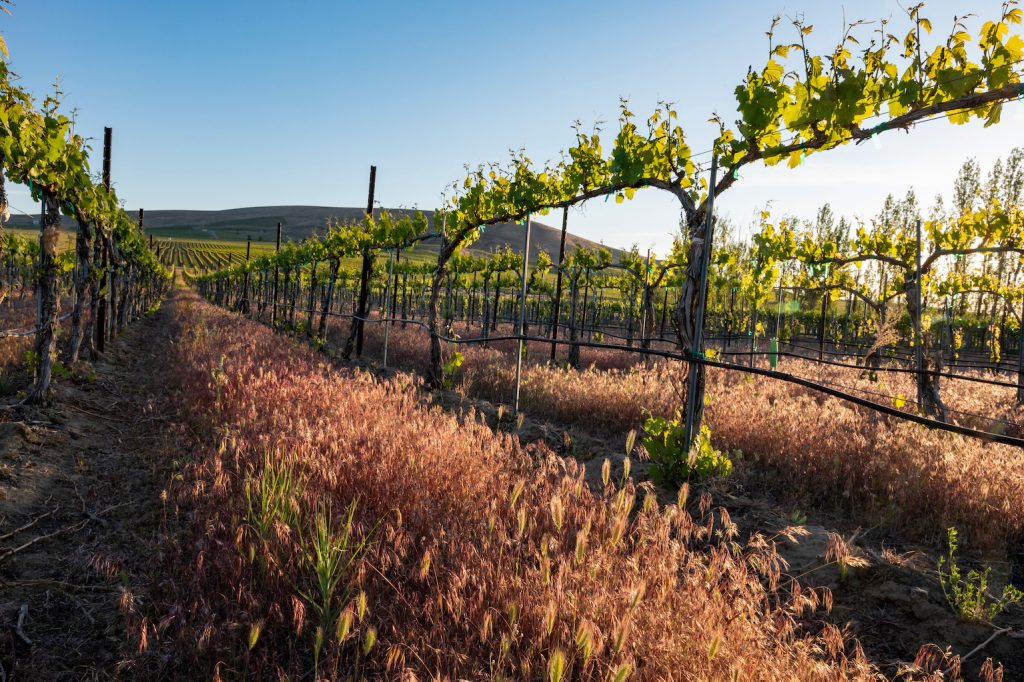Washington Wine Industry Launches Sustainable Certification
“From pest and disease management to sustainable water management, prioritizing worker health and safety and tracking various inputs, this program is environmentally sound, socially equitable, and economically viable,” said Sustainable WA Program Manager Katlyn Slone.
Sustainable WA is the first certified sustainability program built specifically for Washington vineyards. To achieve certification, growers must commit to sustainable viticultural practices and pass a third-party audit to ensure operations meet established standards. After initial certification, Sustainable WA vineyards require an audit every three years during which continual improvement must be shown.
“Sustainable WA is built on the tenet that sustainability is a journey and is dedicated to ongoing evaluation and continual improvement,” Slone said. “It takes a rigorous and balanced look at all pillars of sustainability without leaning too heavily on one. Balance is the priority.”
The program offers certification for vineyards with plans to add certification for wineries in the future. Wineries may utilize the Sustainable WA logo on wine labels to signify the wine is made with certified grapes.
“Data shows the demand for sustainable products to be high,” said Steve Warner, president of the Washington State Wine Commission. “This program is imperative for the future of Washington wine not only to ensure healthy, productive vineyards and wineries for generations to come, but also to remain relevant in the global marketplace.”
Sustainable WA is two decades in the making. The Washington wine industry created an educational sustainability program called Vinewise\Winerywise over 20 years ago, to be intentionally scalable for certification. In 2019, an industry committee made up of 40+ Washington growers, vintners, and marketing professionals built upon the existing program to create Sustainable WA alongside leading sustainability consultant SureHarvest. This year, a small group of volunteer growers participated in a Beta test to provide feedback before full launch.
“Sustainability is part of our culture and our nature. It’s remarkable witnessing the past 20 years from educational tools to a statewide program,” said Vicky Scharlau, executive director of Washington Winegrowers. “Sustainable WA was built entirely for this industry and by this industry. We are excited for the full launch this summer.”
Sustainable WA is a collaboration between the Washington Winegrowers, the Washington State Wine Commission, the Washington Wine Industry Foundation and the Washington Wine Institute.
Keep updated on the specialty food and beverage industries by subscribing to Gourmet News. The August issue will feature wines and wineries!
Southern Glazer’s Donates $100K for Humanitarian Aid in Ukraine
 Alcohol beverage distributor Southern Glazer’s Wine & Spirits is donating a total of $100,000 across three charitable organizations supporting humanitarian aid in Ukraine. The donation is the result of an employee fundraising campaign, in which Southern Glazer’s matched employee contributions to organizations performing meaningful work to help Ukrainian refugees.
Alcohol beverage distributor Southern Glazer’s Wine & Spirits is donating a total of $100,000 across three charitable organizations supporting humanitarian aid in Ukraine. The donation is the result of an employee fundraising campaign, in which Southern Glazer’s matched employee contributions to organizations performing meaningful work to help Ukrainian refugees.
In support of the Ukrainian community, Southern Glazer’s pledged to support World Central Kitchen, United Nations High Commissioner for Refugees and Cooperative for Assistance and Relief Everywhere through its donation match campaign. All individual employee donations were made for humanitarian aid in Ukraine through Southern Glazer’s internal giving platform, VolunCheers Online, in order to qualify for the match.
Based on employee contributions and the company match, Southern Glazer’s will be donating $42,214, $40,127.52 and $17,659 respectively to WCK, UNHCR and CARE with the hope that the funds will help the organizations respond with supplies and resources needed to help those affected by the current crisis.
“Southern Glazer’s stands in support of the Ukrainian people and wfe cannot thank our employees enough for their generous contributions to this campaign,” said CEO Wayne E. Chaplin. “Through our VolunCheers platform, we are able to rally our workforce around providing humanitarian relief for Ukraine and its neighboring countries. We are thankful for the meaningful work these charities are spearheading to ensure families are given the supplies and resources needed.”
For updates on news in the specialty food and beverage industries, subscribe to Gourmet News.
Jack Daniel’s Launches First Super Premium Whiskey Line Extension in 25 Years
The Jack Daniel Distillery introduces Jack Daniel’s Bonded Tennessee Whiskey and Jack Daniel’s Triple Mash Blended Straight Whiskey as the first two permanent expressions in the brand’s new Bonded Series. The Bonded Series honors the whiskey making excellence of the iconic Jack Daniel Distillery and will be a permanent extension in the Jack Daniel’s Family of Brands.
Both Jack Daniel’s Bonded and Triple Mash are Bottled-in-Bond at 100 proof (50% abv), with packaging inspired by the original design of the 1895 Jack Daniel’s Tennessee Whiskey bottle. As stipulated by the Bottled in Bond Act of 1897, a bonded whiskey must be distilled by a single distiller during a single season, matured in a government bonded warehouse for at least four years and bottled at 100 proof.
“The Jack Daniel Distillery has been making exceptional American whiskey to the highest standards for generations, before and after the Bottled in Bond Act, dating back to the days of Mr. Jack himself,” said Chris Fletcher, Jack Daniel’s master distiller. “Jack Daniel’s Bonded and Triple Mash are a nod to our heritage with a touch of innovation and craftsmanship. These whiskeys are another opportunity for both our friends and new drinkers to explore and discover everything Jack Daniel’s has to offer.”
Jack Daniel’s Bonded and Triple Mash will be available across the United States \in May with international markets to follow later in 2022. It will initially be available in 700mL bottles for suggested retail prices of $29.99 and $32.99 respectively. They will be available for pre-sale through ReserveBar beginning May 3, including a limited edition Jack Daniel’s gift item while supplies last.
For updates on specialty foods and beverages, subscribe to Gourmet News.








